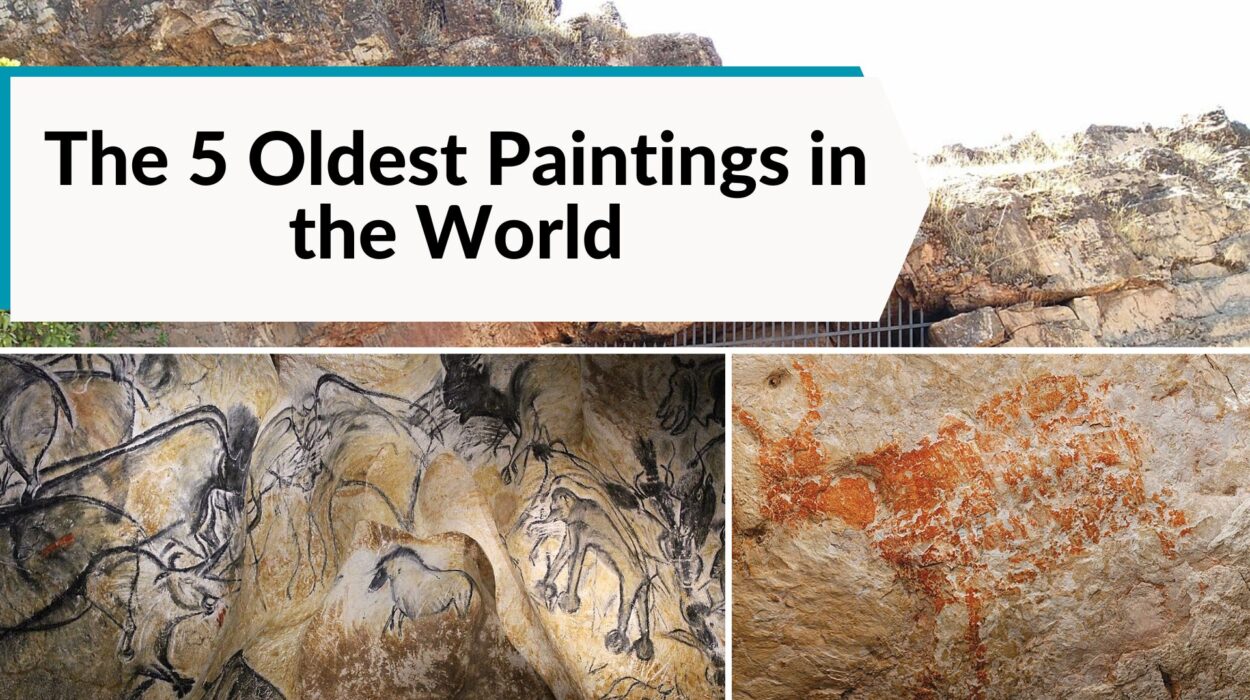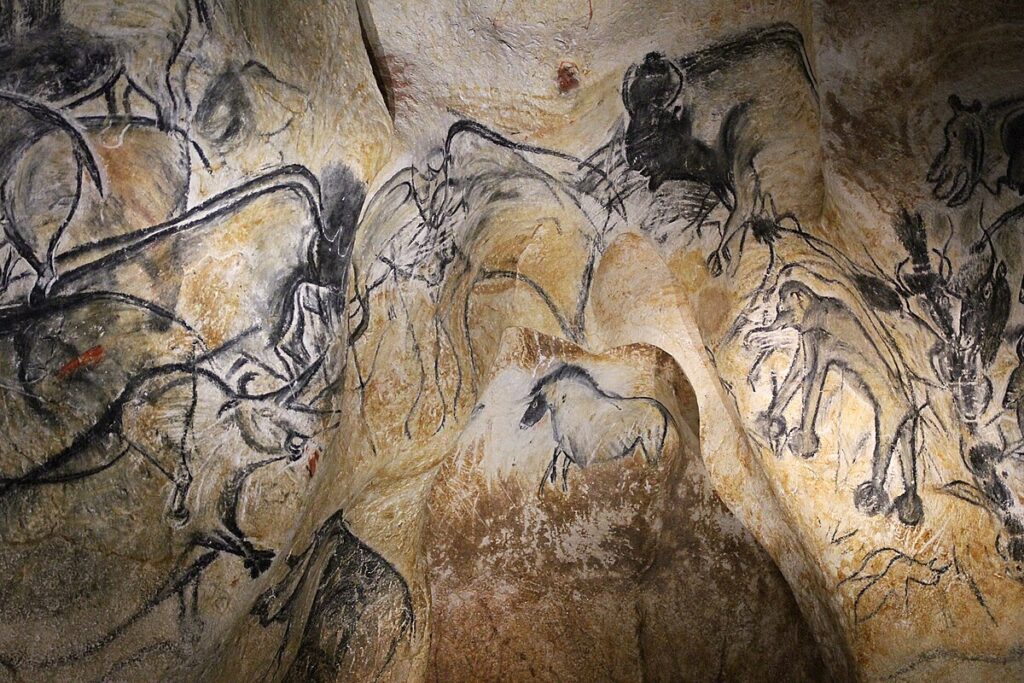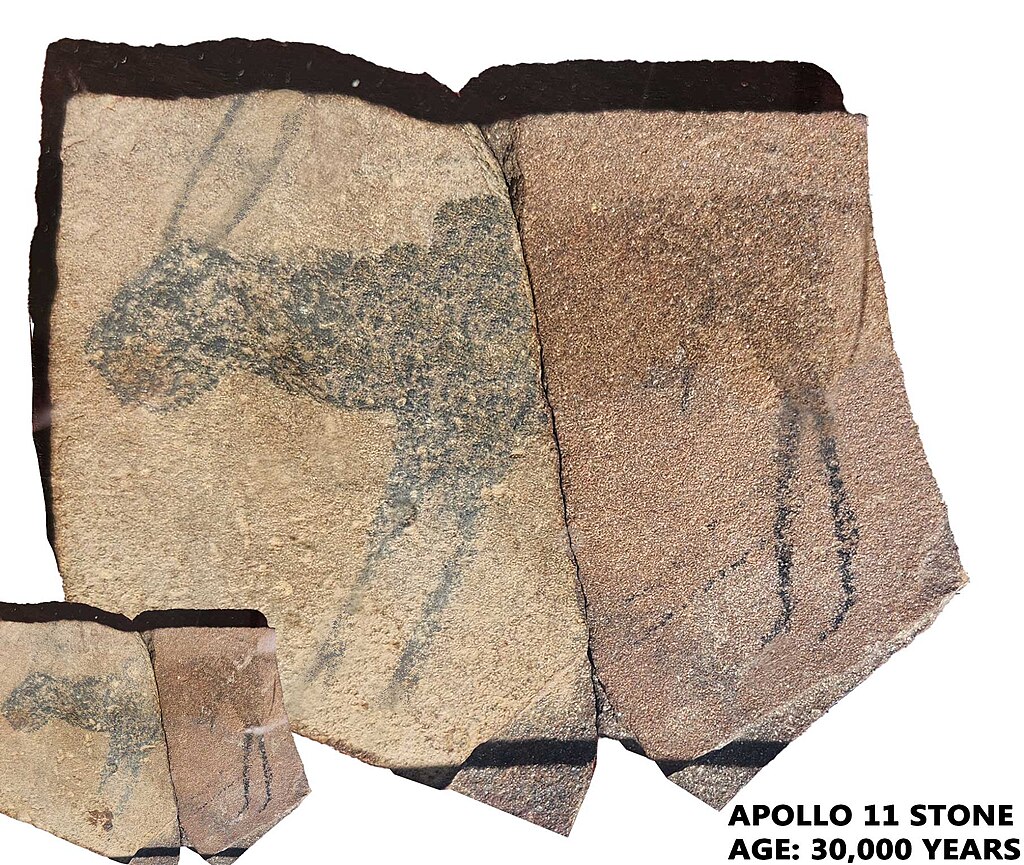Art has always been a timeless way to show how creative and cultural people are. The oldest paintings in the world, which range from simple hand stencils in caves to highly detailed pictures of animals, give us a fascinating look into the minds and lives of our ancestors. These works of art, which were carved into cave walls tens of thousands of years ago, show how people first started to use stories and symbols to communicate.
This blog post looks at five amazing places where the oldest paintings in the world were found. Each one reveals new information about how people lived in the past, their creativity, and how they were connected to the world around them. Now let’s look at these amazing pieces of prehistoric art!
- Maltravieso Cave, Spain
- Leang Tedongnge Cave, Sulawesi, Indonesia
- Chauvet Cave, France
- Lubang Jeriji Saléh Cave, Borneo, Indonesia
- Apollo 11 Cave, Namibia
Maltravieso Cave, Spain
In February 2018, a groundbreaking study came out in Science magazine and caused a lot of buzz in the scientific community. The University of Southampton released results that challenged long-held ideas about where cave art came from, bringing the focus to Spain’s ancient caves.
The study was mostly about three caves in Spain: Ardales (Andalusia), La Pasiega (Cantabria), and Maltravieso (Extremadura). Scientists found amazing things by using uranium-thorium dating, a method that figures out how old calcium carbonate deposits are that cover cave art. Paintings in El Castillo cave in Cantabria that were dated to more than 40,000 years ago showed that the method worked well. This new research, on the other hand, pushed the date back even more.
The Maltravieso Cave is a secret time capsule.
The Cave of Maltravieso was found in 1951 during an explosion in a limestone quarry. It contained a wealth of artifacts, including human skulls, animal bones, ceramics, and tools, which are now all kept at the Museum of Cáceres. But it wasn’t until 1956 that the most amazing secret on its walls came out: researcher Carlos Callejo found 71 negative hand stencils.
The old age of these stencils is what makes them unique. Scientists recently looked at carbonate deposits on top of a stencil’s red color and found that it is about 66,700 years old. Since this happened before Homo sapiens came to Europe, it’s likely that Neanderthals made the art.
The Neanderthals were artists?
This discovery has very important effects. It goes against what people have always thought about Neanderthals’ abilities if they really did make these hand stencils. It was once thought that Neanderthals did not have the cognitive skills of Homo sapiens, but it turns out that they may have had symbolic thinking and a sense of creativity much earlier than was thought.
The Cave of Maltravieso would then be one of the oldest examples of cave art in the world, and our understanding of how people lived in the past would need to be rethought. The find also raises a bigger question: how much more information about our ancestors is still hidden in caves that haven’t been explored?
A New Look at the History of People
The discoveries in Maltravieso, along with similar ones in La Pasiega and Ardales, show that Neanderthals may not only have been able to make art, but they may have been the first people in Europe to do so. This new information makes it harder to tell the difference between Neanderthals and modern humans. It also shows how creativity and culture have roots in the same places.
We learn more about the past with each new discovery. Maltravieso’s handprints story shows us that history is not set in stone, but written on it.
Leang Tedongnge Cave, Sulawesi, Indonesia
Archaeologists from Australia and Indonesia have found a painting of a Sulawesi warty pig that is thought to be at least 45,500 years old. This is a very important find. This piece of art was found in Leang Tedongnge cave on the island of Sulawesi in Indonesia. It is now thought to be the oldest representational art in the world.
How the Sulawesi Warty Pig Piece Was Made
Sulawesi warty pig (Sus celebensis), a native species known for its short legs and unique facial warts, is shown in the red ochre pigment painting. The piece of art is about 136 cm by 54 cm (53.5 by 21.3 inches) and shows the pig from the side with a detailed outline of its body. There are no obvious sexual features on the pig. The pig is shown with two hand stencils, which give the piece a personal, almost signature-like feel.
Notably, the pig looks like it is watching two other pigs interact with each other, possibly in a fight or a social situation, as shown on the same cave wall. Professor Adam Brumm from Griffith University says that this scene shows not only artistic skill but also a glimpse into how people told stories and lived in the past.
A Place for Artists to Get Away
Leang Tedongnge cave is hidden in a valley and can only be reached during the dry season through a narrow room inside the cave. A group of people called Bugis live in the area and say that no one from the West had been there before this discovery.
The researchers also looked at a second site called Leang Balangajia 1. There is another large painting of a pig on the ceiling of a small side chamber. This figure is 187 cm by 110 cm (73.6 by 43.3 inches), which is bigger than the one at Leang Tedongnge. It is surrounded by four hand stencils that overlap and animal designs that aren’t well preserved.
Finding Out About Prehistoric Art
Uranium-series dating was used to find out how old the paintings were by looking at the calcium carbonate deposits, which are also called “cave popcorn,” that formed on them. At Leang Tedongnge, this kind of deposit on the pig’s back foot meant that it was at least 45,500 years old. It was found that the painting at Leang Balangajia 1 is at least 32,000 years old.
This find is older than the oldest known rock art scene, which was also found in Sulawesi and showed hybrid human-animal figures hunting pigs and dwarf bovids 43,900 years ago.
How Important the Findings Are
People have been hunting Sulawesi warty pigs for a long time, and they are the animals most often shown in the island’s Ice Age art. This shows how important they were to early human societies’ culture and maybe even as symbols.
According to Professor Maxime Aubert, these results suggest that the rock art on Sulawesi is some of the earliest proof of humans with modern bodies in Wallacea. Wallacea, a group of islands between Asia and Australia, was an important way for early humans to get to Australia more than 65,000 years ago.
Even though Wallacea is important, it hasn’t been studied much by archaeologists. They think that more research into Sulawesi’s rock art will lead to even more amazing discoveries.
This old painting not only shows how early humans expressed themselves culturally and artistically, but it also helps us understand how they moved around and interacted with their surroundings. It was written up in detail in a paper that was published in Science Advances.
Chauvet Cave, France
This cave is hidden in the Ardèche region in southern France. It is a wonderful treasure trove of prehistoric art. This Paleolithic site was found in 1994 by Jean-Marie Chauvet, Éliette Brunel, and Christian Hillaire. It is famous for the amazing paintings and engravings that were found there. The art is thought to be between 33,000 and 30,000 years old. These are some of the oldest pieces of art that we know of. They show a level of sophistication that changes the way we think about early human creativity.
Not only is the Chauvet Cave a great work of art, but it is also a great example of how people lived during the Aurignacian period. It has been named a UNESCO World Heritage site, which means it will be protected and studied more.
Discovery and Preservation
The explorers found this hidden gem on December 18, 1994, while looking into a draft of air coming from a crack near the Pont-d’Arc. They were shocked to find that the walls were covered with paintings and engravings of animals, handprints, and geometric shapes as they went deeper. Our ancestors’ lives and artistic projects were revealed in a way that has never been seen before by this discovery.
To protect the site, the Chauvet Cave is still locked up and only researchers are allowed to go inside. Because of the damage that tourists have done to other prehistoric caves, the Pont-d’Arc Cavern was built nearby as an exact copy. This way, people can enjoy the beauty of the cave without putting the original at risk.
Artistic Excellence
The art in the cave shows that the artists had a deep understanding of shape, movement, and technique. Charcoal, red ochre, and hematite were used by the artists to make their art. To make the walls look better, they scraped them clean first. They used creative techniques like shading, drawing with sticks, and even spraying color on the walls.
There are more than 420 pictures of animals in the cave. These pictures include lions, rhinoceroses, bears, and horses. These animals, many of which were not common prey, seem to have a spiritual or symbolic meaning. The Panel of the Lions, which shows a dramatic hunt, and the Panel of the Rhinos, which shows a group of moving rhinoceroses using perspective, are both important works.
Cultural Significance
The Chauvet Cave tells us about the Aurignacian people, who lived in Europe between 40,000 and 28,000 years ago and were hunters and gatherers. They got by with tools and creativity and lived in peace with cave lions and bears, which were their natural enemies. The art makes me think that these early humans may have had spiritual beliefs. The paintings could have been used in rituals or as symbols.
A Legacy Preserved
The Chauvet Cave is proof of how creative and resourceful people are over time. We have wanted to express ourselves and connect through art for tens of thousands of years. This piece connects us to people from the past and the present. This prehistoric wonder is now sealed off to protect its fragile beauty. It continues to amaze and amaze, connecting us to our shared past.
Lubang Jeriji Saléh Cave, Borneo, Indonesia
A huge find in a cave on the island of Borneo in Indonesia has changed the way we think about how creative early humans were. Figurative paintings from at least 40,000 years ago have been found by researchers. They are the oldest examples of this type of art that are known to exist. This discovery fits with similar rock art found on the nearby island of Sulawesi. That island has hand-stencil art from at least 40,000 years ago and other figurative art from about 35,000 years ago.
The study was led by Dr. Maxime Aubert from Griffith University. They used uranium-series analysis to figure out how old a painting of an animal in Lubang Jeriji Saléh cave is. “A large painting of an unknown animal, most likely a Bornean banteng—a species of wild cattle that can still be found in Borneo’s jungles,” Dr. Aubert said. “At least 40,000 years old, this is the world’s oldest known work of art with people in it.”
A Shared Artistic Tradition Across Early Human Cultures
The results suggest that between 52,000 and 40,000 years ago, a Paleolithic rock art style began to appear in Borneo. This tradition probably made its way to Sulawesi and other places, maybe even with the first people who came to Australia. The study also found an interesting change in culture that happened about 20,000 years ago. During this time, rock artists started making a new style of art that included some rare pictures of people. This change happened at the same time as the worst part of the Ice Age, which suggests a link between changes in the environment and changes in culture.
“The identities and fates of these Ice Age artists are still unknown,” said Dr. Pindi Setiawan, an archaeologist from the Bandung Institute of Technology in Indonesia. Dr. Adhi Agus Oktaviana, a rock art expert at Indonesia’s National Research Center for Archaeology, said, “These results show how complicated the development of cave art traditions was.”
Shifting the Focus of Ancient Art History
Europe has been thought of as the center of early cave art for many years. Borneo, the world’s third-largest island, disagrees with this idea. During the Ice Age, Borneo was the most eastern point of the huge plains of Eurasia. A co-author from Griffith University, Dr. Adam Brumm, said, “It now appears that two distinct cave art traditions arose simultaneously in the far corners of Paleolithic Eurasia—one in Europe and another in Indonesia.”
The study, which was published in Nature, not only shows how smart early humans were in Southeast Asia, but it also shows how important it is to change how we think about the art of the past. These results give us new ways to look into where creativity came from and how it spread during the Paleolithic period.
Apollo 11 Cave, Namibia
Africa is known as the “cradle of humanity,” and its many archaeological sites show that this is true. The Apollo 11 cave stones, which were found in Namibia, are one of the most interesting things ever found on the continent. Early humans were very creative, and these amazing artifacts show how they did it.
Over 100,000 sites with ancient rock art have been found across Africa, but many more are still not fully explored. The Apollo 11 cave stones, on the other hand, stand out because they have a special story. It’s interesting that their name has nothing to do with space travel. Instead, they were named after the 1969 Apollo 11 moon landing, which happened at the same time they were found.
The piece of art is made up of seven small granite slabs that are each decorated with drawings of animals made with charcoal, ochre, and white pigment. There are recognizable shapes of a zebra, a rhino, and parts of an unknown four-legged animal that are spread out over two slabs. The designs on the other stones are faint and abstract. It is thought that these ancient works of art are around 25,000 years old, which makes them some of the oldest examples of creative thinking and art in human history.
Other Noteworthy African Rock Art Sites
African rock art is more than just the Apollo 11 cave stones. Other important sites in this group include the Blombos Cave and the Drakensberg rock art in South Africa.
Blombos Cave doesn’t have any rock art that has survived, but it does have signs of a prehistoric artist’s studio. The tools and paints that have been found here are over 100,000 years old, which gives us a glimpse into the materials and methods that early humans used to make art.
The San people made the rock art in Drakensberg over a very long time. This huge collection of paintings shows people and animals and tells stories about the spiritual and everyday lives of these ancient communities. The San were eventually forced to leave the land where they had grown up, but their art lives on as a reminder of their culture.
Preserving Africa’s Artistic Legacy
More and more is being done to record and protect Africa’s rock art. There are projects like the Trust for African Rock Art and the African Rock Art Image Project at the British Museum that are trying to keep these old treasures from being lost. By protecting these sites, we honor our ancestors’ creativity and ingenuity while also learning more about the history of all people.
From the Apollo 11 cave stones to the vast Drakensberg rock art, Africa’s ancient art continues to amaze and move us, showing us how powerful human expression can be over time.
Thanks for coming with us to look at the oldest paintings in the world. Thanks for reading this trip through time and art. If you liked it, please share it with your friends and followers. Let’s share the beauty of the world’s amazing artistic history!




